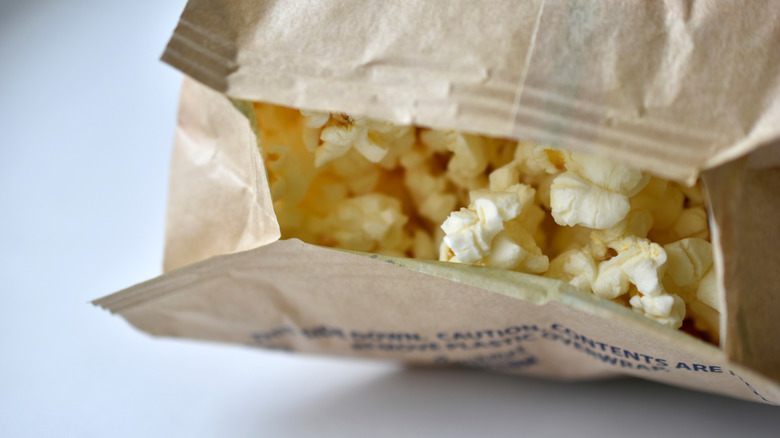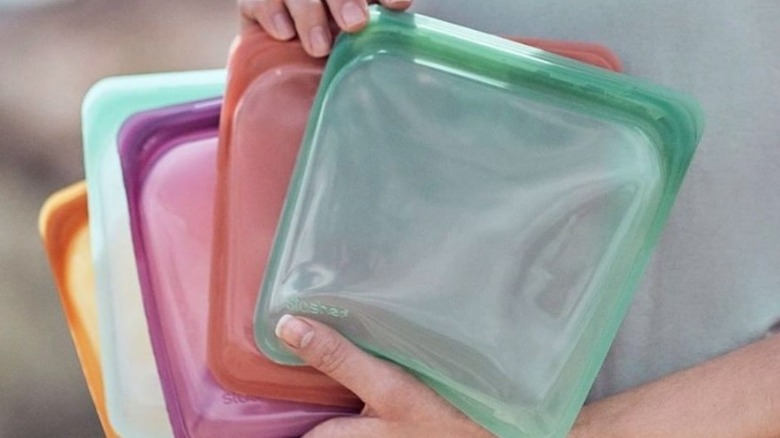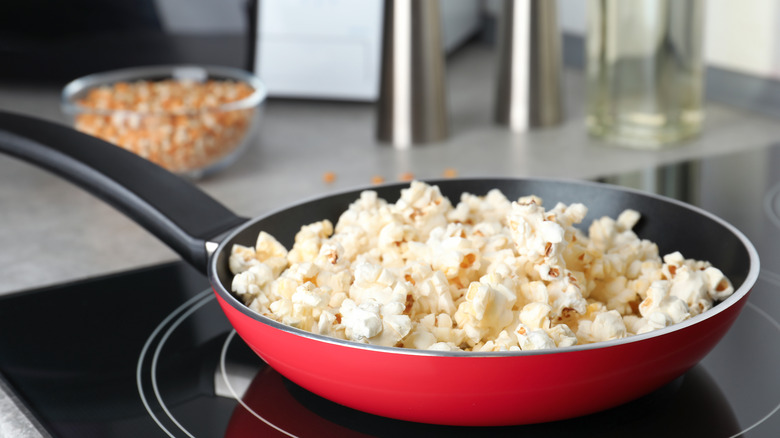A Silicone Bag Is The Secret To Safely Microwaving Popcorn
How many times have you microwaved popcorn before? Probably too many times to count. It's easy — toss the bag in the microwave, set the time, and make sure it doesn't burn, so it's not exactly rocket science here. Why, then, are we focusing on the safety of microwaving popcorn if it's so easy that a kid could do it without any help?
While the American Heart Association reports that popcorn can be a filling and even healthy snack when prepared correctly (like skipping huge amounts of butter and salt), many have focused on not the popcorn itself, but instead the bag the kernels come in. Certain reports have warned consumers that popcorn bags may be lined with "PFAS," or perfluoroalkyl and polyfluoroalkyl substances, which are also known by the ominous name of "forever chemicals." The Environmental Protection Agency also reports that, so common are these chemicals in our environment, that traces of these substances can be found in the bloodstreams of many humans and animals. While this doesn't mean that every time you eat popcorn you're eating chemicals, it's still a surprising fact to learn what exactly your buttery popcorn kernels are being carried in.
So let's say that you want to cut out the microwavable bag entirely. What sort of bag or popping vessel can you use that will allow you to pop your corn safely and efficiently?
You could use a silcone bag to microwave popcorn
If you've already dumped all your kernels into a bowl and tossed out the microwavable bag, you're now finding yourself in another awkward position. What can you put these kernels in that they'll pot the right way? You can't just stick the bowl in there and make it like that, considering the kernels would fly out as they popped.
According to Ann Taylor Pittman of The Kitchn, one of the best ways to microwave popcorn without the microwavable bag is by using a bag made of silicon. Pittman's experiment with the silicone bag included 1/2 cup of popcorn kernels, one tablespoon of olive oil, and half a teaspoon of salt inside of a plastic Stasher-brand bag. She believed that using a silicone bag was "neat and tidy," noting that the appeal of using a silicone bag was that it was also reusable and, so long as it was washed after each use, was a good choice of microwaving popcorn kernels. Others, such as YouTuber Courtney Michael, have attested to the silicone bag's resealing ability to preserve popcorn.
Stasher, the brand Pittman used, also makes the claim that not only is using silicone bags safe and efficient, but it's also good for eliminating waste both food and cost-wise. "Not only will you save some money (and eliminate waste)," the company explains, "but you can easily customize your popcorn flavors to suit your tastebuds."
You can also skip the microwave altogether
Perhaps you don't want to use a paper bag or silicone bag to microwave popcorn. In fact, maybe you want to avoid the microwave altogether and make popcorn another way. How can you prepare popcorn quickly and easily without using the microwave?
Fortunately, preparing popcorn without a microwave is actually very simple. One such method involves taking a cast iron pan or Dutch oven, filling it with a small handful of popcorn kernels, and then adding your choice of oil or butter. Gently shake the pan or pot over medium heat until the first kernels of popcorn begin to pop — this will be the sign that it's time to add the rest of the kernels to the pan. Add your desired amount of kernels and then quickly cover the pan or pot to prevent any heat or wayward kernels from escaping. Once the popping begins to slow down to only a few pops per second, kill the heat and remove the pan or pot from the oven. After that, allow the kernels to cool or, while still warm, add oil, butter, or seasonings.
Whether or not you microwave your popcorn or you pop it on the stove, you can also experiment with different toppings such as ginger and turmeric or a sweet and salty caramel and almond blend. It's your popcorn, and what you do with it is all up to you.


